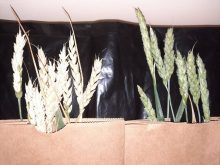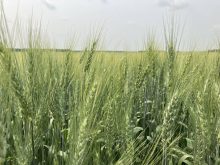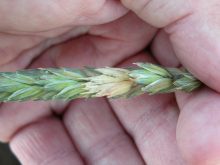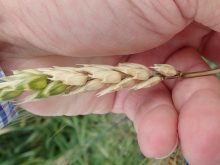Does handling fusarium infected grain pose more risks to producers than regular grain?
It’s a question that yields few answers to the casual researcher or farmer looking for information online. In fact, according to J. David Miller, a professor at Carleton University, you only really hear about the dangers of fusarium damaged grain, and how to handle it, when a really bad year for the fungal disease strikes and interest spikes.
This year is a bad year. According to early reports, many, or most, samples of western Canadian wheat carry at least some signs of the disease.
Read Also

Claas brings 1000 Series SP forage harvesters to Canada
In mid-August, Claas unveiled its new line of Jaguar forage harvesters at an event in Visalia, California, deep in the heart of that state’s dairy region.
Many of those samples also carry varying levels of deoxynivalenol, or DON, (also called vomitoxin), a mycotoxin dangerous to humans and animals that is a byproduct of Fusarium graminearum infection in wheat.
Miller, an expert in fungal toxins and allergens, says it’s the dust from fusarium damaged grain that poses the real problems, as it carries “vastly more” fungus and toxins than the grain itself.
“Dust from fusarium damaged crops is not grain dust anymore,” he says. “It has lots of spores and high concentrations of vomitoxin that are 10 to 100 times higher than within the grain.
- Read more: Marketing fusarium-damaged wheat
“The outside of the grain is more contaminated. The dust contains as much as a 100 times more metabolite than the grain itself.”
It’s well known that grain dust causes plenty of problems on its own — notably, hypersensitivity pneumonitis, or “farmer’s lung.” But dust from fusarium damaged grain carries further complications. For one thing, says Miller, the fusarium fungus is allergenic. If the person exposed is allergic to fusarium, organic dust toxic syndrome (ODTS) is possible. ODTS initially presents with flu-like symptoms; it can result in the need for hospitalization. It can also mean lasting injury to the lungs.
Another complication can come from inhaling grain loaded with DON. DON can affect the normal function of the lungs, increasing susceptibility to respiratory disease.
“The fact that there are very high concentrations of toxins in the dust of highly contaminated grains, that can matter in terms of lung biology,” Miller says.
Symptoms can include those conditions often associated with asthma, pneumonia or flu, including fever and chills, a dry cough or a rapid heart rate. Farmers experiencing such symptoms should get checked out by a physician.
4 ways to stay safe
The level of health risk posed by infected grain depends on the situation and the level of infection. Miller was the lead on a 1994 study of grain handling facilities that demonstrated that handlers’ exposure to fungal infections on top of grain dust did not reach levels of special concern. Still, caution is highly recommended when dealing with damaged grain, particularly if infection levels are high.
There are several safety measures producers can take to minimize the risks.
- Avoid dust clouds. Miller says the most important precaution is to avoid dust cloud situations where handlers are forced to breathe in grain dust particles. Handle grain in well-ventilated conditions upwind of dust kicked up by farm machinery.
- Change the filter. In severely infected fields, Miller recommends changing the filter on the cab. “There is virtually no material risk then,” he says.
- Wear protection. Masks, eye protection, coveralls and gloves can be used when handling severely infected grain.
- Wash your hands. Miller doesn’t beat around the bush when it comes to accidental exposure of bare skin to infected grain dust. “Wash your hands before you take a leak, no matter what your sex. The dust will burn!” he says. “If you wash it off within an hour of contacting it there is no cause for worry.”
Getting rid of the grain
Disposing of severely infected grain is an absolute last case scenario for growers who have not been able to move damaged grain via any marketing channels. If grain is this badly damaged, it should be disposed of very carefully, both to minimize spreading the pathogen and to protect handlers.
Miller says producers can choose to bury or burn damaged grain. If they choose to bury it, grain should be buried deeply away from farm fields, and handlers should take care to avoid breathing in the dust.
Farmers choosing to burn can incinerate the grain in biomass plants. Very high temperatures are required to completely destroy fusarium damaged grain — this is harder to do in an open pile.
“The concern is if you dump it in a pile and set it on fire you do have to make sure it’s destroyed so it doesn’t leave inoculum in the soil,” says Miller.
















